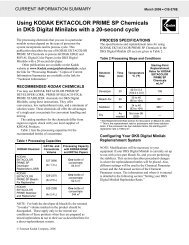Downloaded - Kodak
Downloaded - Kodak
Downloaded - Kodak
Create successful ePaper yourself
Turn your PDF publications into a flip-book with our unique Google optimized e-Paper software.
Processing Steps<br />
Backing Removal Solution<br />
Processing Cycle<br />
The alkaline backing removal solution converts the rem-jet antihalation backing on the film base into<br />
a water-soluble form. The backing removal wash removes this backing.<br />
Backing Removal Wash<br />
This wash performs 2 functions:<br />
1. Removes the backing removal solution from the film<br />
2. Completely removes the solubilized antihalation backing from the base by a combination of water<br />
action and mechanical buffing.<br />
First Developer Solution<br />
In the first, or negative, developer solution, only the exposed silver halide grains (latent images) are<br />
reduced to metallic silver by the action of Phenidone* and hydroquinone developers.<br />
Ag +<br />
(Exposed<br />
Silver<br />
Halide)<br />
The resulting silver grains form three superimposed negative images of the original scene, one image<br />
in each of the red-, green-, and blue-sensitive emulsion layers. The remaining (unexposed and<br />
undeveloped) silver halide in the three emulsion layers constitutes the positive (reversal) images that<br />
are later converted to full-color images in the color-development phases of the process.<br />
*Phenidone is a trademark of Ilford Limited.<br />
First Developer Wash<br />
This wash stops the negative development and removes the first developer solution from the film.<br />
Red Reexposure Printing<br />
+ Developer → Ag°<br />
(Negative<br />
Silver<br />
Images)<br />
+ Oxidized<br />
Developer<br />
+ X -<br />
(Halide<br />
Ions)<br />
The red reexposure printing step completely reexposes all of the remaining silver halide in the red<br />
sensitive (bottom) emulsion layer so that the silver halide develops completely in the cyan developer<br />
solution. At the same time, exposure of any remaining silver halide in the blue- and green-sensitive<br />
layers must be avoided to prevent unwanted cyan dye development in these layers. This selective<br />
reexposure is obtained by printing through the base side of the film, using a properly selected red glass<br />
filter in the light beam. The green and blue-sensitive emulsion layers have no intentional sensitivity to<br />
red light and should, therefore, remain unaffected by the red-light exposure. However, some greensensitive<br />
emulsion layers do have a slight, but significant, red sensitivity, and accurate control of the<br />
red printing intensity is necessary.<br />
TG2044-1 – 06APR99 27
















